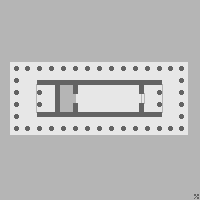
Adyton
Encyclopedia

Latin
Latin is an Italic language originally spoken in Latium and Ancient Rome. It, along with most European languages, is a descendant of the ancient Proto-Indo-European language. Although it is considered a dead language, a number of scholars and members of the Christian clergy speak it fluently, and...
) was a restricted area within the cella
Cella
A cella or naos , is the inner chamber of a temple in classical architecture, or a shop facing the street in domestic Roman architecture...
of a Greek
Greek temple
Greek temples were structures built to house deity statues within Greek sanctuaries in Greek paganism. The temples themselves did usually not directly serve a cult purpose, since the sacrifices and rituals dedicated to the respective deity took place outside them...
or Roman temple
Roman temple
Ancient Roman temples are among the most visible archaeological remains of Roman culture, and are a significant source for Roman architecture. Their construction and maintenance was a major part of ancient Roman religion. The main room housed the cult image of the deity to whom the temple was...
. Its name meant "inaccessible" or "do not enter". The adyton was frequently a small area at the farthest end of the cella from the entrance: at Delphi
Delphi
Delphi is both an archaeological site and a modern town in Greece on the south-western spur of Mount Parnassus in the valley of Phocis.In Greek mythology, Delphi was the site of the Delphic oracle, the most important oracle in the classical Greek world, and a major site for the worship of the god...
it measured just nine by twelve feet. The adyton would often house the cult image
Cult image
In the practice of religion, a cult image is a human-made object that is venerated for the deity, spirit or daemon that it embodies or represents...
of the god. Adyta were spaces reserved for oracles, priests or acolytes, and not for the general public. Adyta were found frequently associated with temples of Apollo
Apollo
Apollo is one of the most important and complex of the Olympian deities in Greek and Roman mythology...
, as at Didyma
Didyma
Didyma was an ancient Ionian sanctuary, the modern Didim, Turkey, containing a temple and oracle of Apollo, the Didymaion. In Greek didyma means "twin", but the Greeks who sought a "twin" at Didyma ignored the Carian origin of the name...
, Bassae
Bassae
Bassae or Bassai, Vassai or Vasses , meaning "little vale in the rocks", is an archaeological site in the northeastern part of Messinia Prefecture that was a part of Arcadia in ancient times. Bassae lies near the village of Skliros, northeast of Figaleia, south of Andritsaina and west of Megalopolis...
, Clarus
Clarus
Clarus in the territory of Colophon in the Ionian coast of Asia Minor was a much-revered, much-famed cult center described by Pausanias ....
, Delos
Delos
The island of Delos , isolated in the centre of the roughly circular ring of islands called the Cyclades, near Mykonos, is one of the most important mythological, historical and archaeological sites in Greece...
and Delphi
Delphi
Delphi is both an archaeological site and a modern town in Greece on the south-western spur of Mount Parnassus in the valley of Phocis.In Greek mythology, Delphi was the site of the Delphic oracle, the most important oracle in the classical Greek world, and a major site for the worship of the god...
, although they were also said to have been natural phenomena (see the story of Nyx). In modern usage, the term is sometimes extended to similar spaces in other cultural contexts, as in Egyptian temple
Egyptian temple
Egyptian temples were built for the official worship of the gods and commemoration of pharaohs in Ancient Egypt and in regions under Egyptian control. These temples were seen as houses for the gods or kings to whom they were dedicated...
s.
Sources
- Broad, William J. The Oracle: The lost secrets and hidden messages of ancient Delphi. Penguin Press, 2006.

